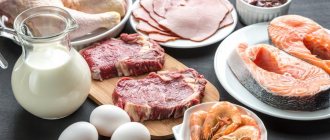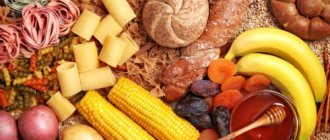In this article we will tell you:
- Classification of carbohydrates
- Daily intake of fructose and sugar
- Interesting facts about carbohydrates
- Foods rich in complex carbohydrates
- Daily carbohydrate intake and glycemic index
- 6 Rules for Eating Carbohydrates
- Symptoms and causes of carbohydrate metabolism disorders
- Low carb diets
- Fast carbohydrates for gaining muscle mass
- General carbohydrate intake recommendations
Complex carbohydrates are needed by the body to provide energy. Their deficiency causes a feeling of hunger. Many foods are rich in complex carbohydrates.
The main function of carbohydrates is to provide the body with energy. Although carbohydrates as sources of energy can be replaced by proteins and fats, the absence of carbohydrates in food can adversely affect health.
Classification of carbohydrates
Carbohydrates
- organic compounds that are part of all living organisms.
The lack of carbohydrates in food is manifested by symptoms reminiscent of starvation. There is rapid loss of water and sodium.
They are divided into monosaccharides, oligosaccharides and polysaccharides.
| Functions | Characteristic |
| Energy | The main substrate for energy production. |
| Structural | They are membrane components and participate in the production of lipids and non-essential amino acids. |
| Storage | Glycogen in the liver and muscles is a reserve of nutrients. |
| Regulatory | Digestive regulators. |
| Receptor | Cell receptors are glycoproteins. |
| Protective | Antibodies – glycoproteins, mucus, heparin. |
| Information | Ribose is a key component of RNA and DNA. |
- Simple carbohydrates
Water-soluble white crystals, sweet in taste, quickly absorbed, substrate for fermentation reactions. They have a higher glycemic index and cause insulin spikes in the blood.
Simple carbohydrates are called monosaccharides and oligosaccharides.
- Monosaccharides
Galactose, milk sugar, is a component of lactose and is found in milk.
Glucose, grape sugar - found in grapes, fruits, honey. It is the end product of the breakdown of complex carbohydrates in the body and is easily fermented.
Fructose, fruit sugar, is 2.5 times sweeter than glucose and does not cause a rise in insulin. Contained in honey and fruits. Worse to ferment.
- Oligosaccharides
Sucrose (glucose + fructose), cane beet sugar - table sugar. Contained in honey, dates, grapes, figs, persimmons, prunes, raisins. Displaces copper, chromium and B vitamins from the body, increasing the risk of developing CVD.
Lactose (glucose + galactose), milk sugar - easily transforms into adipose tissue (used for weight gain), stimulates the growth of lactic acid bacteria in the intestines.
Maltose (glucose + glucose), malt sugar, is an intermediate product of starch hydrolysis. Contained in wheat, rye, malt extracts, sprouted grains.
- Complex carbohydrates
Peculiarities:
- Low glycemic index.
- Does not cause insulin spikes.
- They have a mechanical effect on the intestines.
- Slow down the process of movement of the food bolus through the gastrointestinal tract.
Complex carbohydrates include polysaccharides. Polysaccharides are divided into homopolysaccharides and heteropolysaccharides.
- Homopolysaccharides
Starch is the stored energy of plants. Digestion of starch begins in the mouth. Contained in potatoes, cereals, pumpkin, peas.
Glycogen is animal starch, stored energy. Synthesized during digestion (1-2 hours after ingestion of carbohydrate foods), the largest amount of glycogen is stored in the form of granules in liver cells (2/5 - 150g), in skeletal muscles (1-3%), in the heart (0.5% ).
Cellulose (fiber) is the main component of the cell wall of higher plants, algae. Promotes the movement of food through the intestines, is broken down in the large intestine with the participation of microbiota, and inhibits the absorption of microelements.
Hemicellulose is better soluble in water and has sorption properties.
Lignin is the matrix of plants, determines their strength, the richest is coniferous wood, and from food sources: bran, stale vegetables. It is not digested in the intestines, reduces food digestion and absorption and has a high sorption capacity.
- Heteropolysaccharides
Pectin is present in the intercellular space of all higher plants, most of all in fruits. It has mild sorption and chelator properties.
We recommend
“Microelements in the body: consumption standards and methods of replenishing the deficiency” Read more
Inulin is similar to starch. Contained in underground parts of plants (mostly in Jerusalem artichoke, chicory), binds glucose, prebiotic.
Fiber and starch
These two components represent two types of difficult-to-digest carbohydrates. Fiber is especially important because it promotes bowel regulation and helps control cholesterol levels.
The main sources of dietary fiber are:
- fruits
- vegetables
- nuts
- beans
- whole grains
Starch is also found in some fiber foods. The difference is that some foods are considered more starchy than fibrous, such as potatoes.
Video
Other foods high in starch:
- whole wheat bread
- wheat
- corn
- oats
- peas
- rice
What complex carbohydrates are is the key to long-term health and weight loss. They make it easier to maintain your weight and may even help protect against type 2 diabetes and cardiovascular problems in the future.
Fructose consumption rate
Consumption rate: maximum 25 g per day.
In people with metabolic syndrome and risk factors: no more than 15 g.
50 g per day can cause metabolic syndrome and other diseases (metabolic gout).
Sources of fructose:
- Fruits.
- Vegetables.
- Honey.
- Products with fructose.
- High fructose corn starch.
- Sucrose – table sugar (glucose + fructose).
Sources of fructose in fruits and berries:
| Fruit | Size | Fructose (g) |
| Lime | 1 medium | 0 |
| Lemon | 1 medium | 0,6 |
| Cranberry | cup | 0,7 |
| Passion fruit | 1 medium | 0,9 |
| Plums | 1 medium | 1,2 |
| Apricot | 1 medium | 1,3 |
| Date (Deglet Noor) | 1 medium | 2,6 |
| Raspberries | 1 cup | 3,0 |
| Clementines | 1 medium | 3,4 |
| Kiwi | 1 medium | 3,4 |
| Blueberry | 1 cup | 3,5 |
| Cherries | 10 | 3,6 |
| Strawberry | 1 cup | 3,8 |
| Cherry | 1 cup | 4,0 |
| A pineapple | 1 piece | 4,0 |
| Grapefruit | 1.2 average | 4,3 |
| FRUIT | SIZE | GR. FRUCTOSE |
| Mandarin | 1 cup | 4,8 |
| Nectarine | 1 medium | 5,4 |
| Peach | 1 medium | 5,9 |
| Orange | 1 medium | 6,1 |
| Papaya | 1/2 medium | 6,3 |
| Honey Melon | 1/8 average | 6,7 |
| Banana | 1 medium | 7,1 |
| Date (Medjool) | 1 medium | 7,7 |
| Apple | 1 average | 9,5 |
| Melon farmer | 1/16 average | 11,3 |
| Pear | 1 medium | 11,8 |
| Grape | ¼ cup | 12,3 |
| Seedless grapes | 1 cup | 12,4 |
| Mango | ½ average | 16,2 |
| Dried apricots | 1 cup | 16,4 |
| Dried figs | 1 cup | 23 |
Are fruits really evil? No, fruit is not evil. Different fruits contain different amounts of fructose. Fruits reduce the risk of developing CVD due to their content of other nutrients and polyphenols. They are recommended in many diets, including the DASH (Diet to Stop Hypertension) protocol.
Studies have shown that fruit components such as vitamin C, resveratrol, polyphenols, and antioxidants improve the condition and function of blood vessels. Better fructose + vitamin C in fruits.
The fructose content of fruits is relatively low. The fructose content increases in fruit juices, as do calories. Some fruit juices contain up to 26 g of fructose per 450 g. Some restaurant desserts contain up to 60 g of fructose per serving.
Simple carbohydrates - food list
Fruits and berries: banana, kiwi, lychee, melon, pineapple, watermelon, dates, mango, persimmon.
Vegetables: potatoes, sweet potatoes, carrots, green peas.
Cereals: breakfast cereals, instant cereals, millet, white rice.
Dairy products: rice milk, ice cream, yogurt with fruit.
Sweets and snacks: rice cakes, marmalade, crackers, chips, chocolate, cakes, white bread, chocolate bars, cookies, honey, jam, soda.
For convenience, here is a table of foods with fast carbohydrates:
| Product | Glycemic index |
| Dates | 145 |
| Honey | 89 |
| Watermelon | 76 |
| Chips | 74 |
| Ice cream | 70 |
| Milk chocolate | 70 |
| A pineapple | 67 |
| Melon | 65 |
| Potato | 65 |
| White rice | 64 |
| Banana | 60 |
| Sweet potato | 55 |
Sugar intake per day
Free sugar = added by human hands.
Based on an average daily caloric intake of 2000 kcal, 10% free sugar from the total daily caloric intake of food.
Calculation example
:
- 10% of 2000 kcal = 200 kcal.
- 1 tsp without top sugar = 4 g.
- 1 g sugar = 4 kcal.
- 1 tsp = 16 kcal.
- 200 kcal = 12 tsp. Sahara.
- Daily sugar consumption 12 tsp.
BUT! This is a lot - maximum 50% - 6 tsp.
Another example of calculation for a box of chocolates. Total weight of the product in the box is 370 g. Quantity: 10 candies. 1 candy = 37 grams.
According to the labeling, 100 g of sweets contains 48 g of sugar. 1 candy 37 g = 17.7 g sugar.
17 g sugar = 4 tsp.
2 candies = reserve of “free sugar” allowed by the good WHO per day.
Why exclude complex carbohydrates from the diet?
All this is great, but no matter what diet you take, remove bread from your diet, exclude potatoes, and don’t even sit next to a plate of pasta. Scientific dietology insists that you can eat potatoes, pasta, and even white rice in quantities adequate to your energy expenditure, and continue to lose weight. Or don’t lose weight if you eat healthy buckwheat with a “surplus”. All this is extremely relative, and depends not only on the “complexity” and “purity” of carbohydrates, the glycemic index of foods, but also on such a simple factor as the total number of calories.
Wheat exclusion
One of the newest trends is the elimination of wheat and wheat flour. Such actions are due to the presence in wheat... no, not carbohydrates, but the protein gluten specific to this plant. Gluten is essentially a “gluing” agent and can make it difficult for food to pass through, especially if a person eats little fiber. This is all its “harm” and “danger”.
Gluten is only really harmful to people with celiac disease. In them, it causes gastrointestinal upset with severe diarrhea and abdominal pain. Its use can cause disruption in the absorption of vitamins, and can contribute to metabolic disorders if it is not “noticed” for a long time. True, such things are difficult to “miss”, and wheat is usually excluded as soon as it becomes clear that something is wrong with the absorption of gluten.
Exclusion of all types of grains
This is a “nutrition technology” in which it is proposed to obtain complex carbohydrates from potatoes, Jerusalem artichoke and sweet potatoes. Similar views are often held by supporters of the Paleo diet. However, the scientific explanation for all this is quite vague. The only argument sounds something like “ancient man did not eat grains, so they cause an allergic reaction in us to this day.” Of course, this is all wonderful and surprising, but not all people have allergies, and the majority, nevertheless, are deprived of important vitamins, dietary fiber and... the opportunity to somehow stay within the budget. Well, how many sweet potatoes can you buy and eat? Same thing.
Paleo, in principle, is an insufficiently scientifically substantiated and controversial nutrition system, so at present its requirements should not be considered mandatory.
Excluding only “non-ancient” cereals
Proponents of this approach leave sorghum and millet, or sorghum and amaranth, in their diet, and throw out the rest. The explanation for such activity is so vague that it cannot even be reproduced. In principle, you can, of course, do this, but is it necessary? Big question.
Complex carbohydrates often simply “do not fit” into the calorie intake for one day. This happens especially often in people who try to significantly reduce calories and refuse additional physical activity. These people sometimes have 70-100 g of carbohydrates per day.
But even they are not immune from negative consequences from the nervous system:
- feeling of extreme fatigue, inability to complete even the simplest household tasks;
- impaired cognitive functions - memory, attention disorders, slow reactions, and problems with perception;
- sleep disturbance, inability to fall asleep, or constant waking up in the middle of the night;
- appetite disorders, “in any direction”, from an obsessive desire to constantly chew something, to the complete “disappearance” of appetite.
In principle, all this can be avoided quite simply:
- unless you are a professional athlete, there is no strict need to eat more than 1-1.5 g of protein per 1 kg of body weight. Many people try to eat 2-3 g of protein, which takes away their ability to include carbohydrates in their diet;
- If you add at least half an hour of simple walking and gym 3 times a week, you can consider your physical activity to be average and eat more. You won't need to cut calories to zero to maintain an acceptable weight or reduce your fat percentage;
- as a last resort, you can use carbohydrate cycling, increasing their amount to 3-4 g per day on training days, and decreasing them on rest days. But this is with a significant amount of experience of “staying” on a diet and the need to lose weight, significantly reducing the percentage of fat.
Interesting facts about carbohydrates
- Fats and carbohydrates are highly interrelated. When we don't have enough fat, we may crave carbohydrates.
- Carbohydrates are cellular “firewood”; their first and only function is to provide us with energy. No other molecule can provide as much energy without toxins.
- But besides this there are several more functions. Oddly enough, carbohydrates cannot be called an essential source of food. If there is a lack of carbohydrates, we can live without them, but there will be more toxins, less energy and a depressed state, but our body can create the carbohydrates that we need on its own!
- A carbohydrate is a mixture of carbon and water! Formed in plants under the influence of solar energy. Carbohydrates are an energy pantry: the body is able to store carbohydrates in reserve in the form of glycogen, which is stored in the liver and muscles.
- When the body does not have enough carbohydrates, it is ineffective, drowsy and in a bad mood.
- A special feature of carbohydrates is their ability to sharply increase blood glucose levels. The body’s reaction is immediate: a powerful release of insulin occurs in the pancreas - a hormone designed in this case to neutralize excess glucose in the blood, otherwise it will “thicken”. The main task of insulin is to deliver glucose to the cells that need it, in particular muscle cells.
- Body tissues have a limit for glucose absorption. By getting rid of its excess, insulin promotes its conversion into triglycerides, the main material of adipose tissue. Simple carbohydrates that are not used as sources of energy usually settle in the body in the form of hated subcutaneous fat. This is the reason obesity is so common among people who do not exercise. Their muscles practically do not need energy supply, and almost all the glucose received from food is converted into fat.
- With a sharp increase in blood glucose levels, the synthesis and storage of fat from carbohydrates, as well as the storage of fat from food, is activated. This happens even with a small amount of carbohydrates in food, but with their rapid absorption and with a sudden increase in blood glucose levels. This situation triggers the accumulation of fat in adipose tissue. A factor in the rate of carbohydrate absorption is the glycemic index (GI).
What are complex carbohydrates and why are they healthy?
Complex carbohydrates are polysaccharides with a long molecular chain. It so happens in nature that complex carbohydrates are the key source of energy. This type of polysaccharides includes starch, glycogen, dietary fiber, pectin and a number of other substances, without which normal biochemical processes are impossible.
Complex carbohydrates contain different structural elements that take time to digest. One of these elements is fiber, which is not digested in the stomach. Water-soluble and water-insoluble plant fibers are important for further absorption. In contrast, simple polysaccharides are digested very quickly, without much effort for the body.
The main characteristic that determines the benefits of complex carbohydrates is the glycemic index. For the nutrition of a healthy person and especially a person with diabetes, it is important that the calories contained in food are absorbed gradually. Slow processes of polysaccharide breakdown do not provoke surges in blood glucose. It is recommended for overweight people to consume foods that include complex carbohydrates, since obesity is accompanied by a disorder of insulin synthesis.
A sharp change in blood sugar levels causes a feeling of hunger and stimulates appetite. The introduction of complex carbohydrates into the diet is recommended for people who follow the rules of a healthy lifestyle, diabetics and simply anyone who wants to normalize their metabolism and ensure a normal weight.
It has been proven that plant fibers have probiotic properties, i.e. they stimulate the growth and spread of beneficial intestinal microflora. A healthy intestine fully digests food, provides high immune protection, and controls cholesterol in the blood. Fast, simple carbohydrates do not have these properties, but, on the contrary, suppress intestinal function.
Types of complex carbohydrates
The classification of complex carbohydrates depends on the glycemic index. The following types are distinguished:
- Glycogen - includes glucose molecules connected in a special chain. Maintains a stable concentration of sugar in the blood, promotes the restoration of muscle mass. Glycogen is found in animal products (red meat, beef heart, liver), fish.
- Pectin is a sticky substance that is essentially a derivative of galacturonic acid. The peculiar structure does not allow the carbohydrate to be absorbed, but gives it adsorbing properties. Pectin perfectly absorbs toxins, putrefactive bacteria, pathogens and completely removes them from the body. These qualities provide protection for the mucous membrane of the gastrointestinal tract from mechanical damage and chemical influences.
- Starch is an insoluble plant fiber that ensures a uniform release of energy and long-term satiety after eating. The complex polysaccharide slows down the rise in glucose and blocks insulin surges, thus protecting the pancreas from destructive stress. Thanks to starch, normal metabolism is maintained and the body's defenses are increased. The best sources of starch are oatmeal, brown rice, lentils, pasta, buckwheat, rye bread, potatoes, legumes (soybeans, peas, lentils).
- Fiber is a plant fiber that works like a brush that “cleans out” excess cholesterol. Thanks to fiber, bile flow improves and intestinal function is normalized. The main sources of fiber are berries, seeds and nuts, fruit and vegetable peels, oats, buckwheat, citrus fruits, cabbage, apples, wholemeal flour.
Foods rich in complex carbohydrates
| Product | Carbohydrate content per 100 grams, g |
| Cereals | |
| Cereals | 61 |
| Amaranth | 31 |
| Pearl barley | 65 |
| Bulgur | 76 |
| Millet | 67 |
| Brown rice | 74 |
| Wild rice | 75 |
| Whole grain spelled | 70 |
| Buckwheat | 57 |
| Quinoa | 64 |
| Barley grits | 66 |
| Whole wheat flour | 72 |
| Legumes | |
| Green pea | 15 |
| Beans raw | 12 |
| Dried beans | 49 |
| Chickpeas | 64 |
| Beans | 47 |
| Lentils | 60 |
| Peanut | 14 |
| Vegetables | |
| Carrot | 8 |
| Tomato | 4 |
| Celery | 2 |
| Beet | 6 |
| Turnip | 6 |
| Eggplant | 7 |
| Asparagus | 3 |
| Cucumber | 4 |
| Broccoli | 7 |
| Onion | 7 |
| Radish | 3 |
| Rhubarb | 4 |
| bell pepper | 7 |
| Fresh white cabbage | 5 |
| Red cabbage | 5 |
| Sea kale | 3 |
| Zucchini | 5 |
| Lettuce | 2 |
| Sorrel | 4 |
| Fruits | |
| Pomegranate | 15 |
| Green banana | 22 |
| Apples | 10 |
| Oranges | 8 |
| Figs | 12 |
| Peach | 10 |
| Pear | 11 |
| Grapefruit | 6 |
| Lemon | 3 |
| Avocado | 6 |
| Berries | |
| Cranberry | 4 |
| Prunes | 38 |
| Plum | 10 |
| Raspberries | 6 |
| Blueberry | 8 |
| Gooseberry | 9 |
| Strawberry | 8 |
| Cherries | 10 |
| Currant | 8 |
| Nuts, seeds | |
| Sunflower seeds | 16 |
| Pumpkin seeds | 17 |
| Linen | 12 |
| Sesame | 12 |
| Poppy | 15 |
| Hazelnut | 17 |
| Almonds raw | 20 |
| Cashew | 23 |
| Pine nut | 13 |
| Pistachios | 28 |
| Walnut | 16 |
Which foods contain the most complex carbohydrates?
The classification of carbohydrates into simple and complex, based solely on differences in structure, is not entirely correct. It is more correct to divide polysaccharides according to the glycemic index - the ability of the product to be converted into glucose. The glycemic index (GI) in foods varies from 0 to 100. A high GI indicates rapid absorption of foods, a low GI indicates slow absorption.
The concept of GI was formed when measuring blood sugar levels in the morning after eating a product on an empty stomach.
Based on the data obtained, they distinguish:
- Low GI - less than 55.
- The average GI is 55-69.
- High - more than 70.
It is important to remember that the glycemic index is considered together with the glycemic load. Glycemic load (GL) is calculated based on the carbohydrate content of the product.
GN can be:
- Low - less than 10.
- Average - from 10 to 19.
- High – more than 20.
The optimal combination of these indicators determines the benefits of a high-carbohydrate product.
TOP 10 best foods with the highest content of complex carbohydrates
| Photo | Product: | Kcal: | Carbohydrates (per 100 g) | GI |
| Soybeans | 364 Kcal | 30.2 g | 15 | |
| Black beans | 341 Kcal | 46.9 g | 20 | |
| Lentils | 353 Kcal | 60 g | 25 | |
| Chickpeas | 378 Kcal | 62.9 g | 30 | |
| Wild rice | 357 Kcal | 74.9 g | 35 | |
| Wholemeal bread | 252 Kcal | 42.7 g | 35 | |
| Durum wheat pasta | 352 Kcal | 73.4 g | 40 | |
| Oats | 389 Kcal | 66.1 g | 40 | |
| Buckwheat | 343 Kcal | 70 g | 40 | |
| Green peas (canned) | 81 Kcal | 14.45 g | 48 | |
| Brown rice (unpolished) | 362 Kcal | 76.2 g | 50 |
View the entire table of carbohydrates 350+ ➤
10 more popular foods with long-term absorption:
- Oatmeal - digestion time up to 4 hours, GI - 66.
- Boiled rice - digestible in up to 3 hours, GI - 65.
- Boiled potatoes - digestion takes from 2 to 3 hours, depending on the variety, GI - 65.
- Beets - digestible in 3 hours, GI - 65.
- Raisins - digestible within 2 hours, GI - 65.
- Rye bread - digestion from 3 to 3.5 hours, GI - 65.
- Pearl barley - digestible within 1.5 hours, GI - 22.
- Bananas - digested in 1 hour, GI - 60.
- Cabbage - digestible in up to 4 hours, GI - 10.
- Processed cheese - digestion takes 3 hours, GI - 56.
[Video] Best sources of complex carbohydrates:
Vegetables are record holders
| Photo | Product: | Kcal: | Carbohydrates (per 100 g) | GI |
| Broccoli | 34 Kcal | 6.6 g | 10 | |
| Cabbage | 28 Kcal | 6 g | 15 | |
| Artichoke | 53 Kcal | 12 g | 20 | |
| Beet | 40 Kcal | 11.3 g | 54 | |
| Potatoes (boiled) | 77 Kcal | 19.6 g | 65 |
It should be noted that if potatoes are fried or mashed, the GI will jump to 95. In addition, the calorie content will increase: fried - 184 Kcal, fried - 266 Kcal, chips - 538 Kcal, mashed potatoes - 92 Kcal.
Fruits and berries are record holders
| Photo | Product: | Kcal: | Carbohydrates (per 100 g) | GI |
| Grapefruit | 33 Kcal | 8.4 g | 22 | |
| Prunes | 256 Kcal | 63.9 g | 25 | |
| Dried apricots | 241 Kcal | 62.6 g | 30 | |
| Grape | 64 kcal | 16 g | 40 | |
| Persimmon | 67 Kcal | 16.9 g | 55 | |
| Banana | 89 kcal | 22.8 g | 60 |
Daily carbohydrate intake
| Carbohydrates | Gram per day | Comments |
| Complex carbohydrates | 210 g | Try to avoid simple carbohydrates and maximum complex ones |
| Cellulose | 40 g | |
| Fructose | 25 g | Glycation reactions |
| Sucrose | 25 g, max 50 g | WHO recommends no more than 10% of all carbohydrates, ideally no more than 5% |
| Total | 300 g | For a person with average physical load |
Dietary intake of complex carbohydrates for men and women
Calculating the norm of consumption of complex carbohydrates for men and women depends on age, initial weight, daily activity, and most importantly, on the goal.
Norm for women
For women who want to lose weight, the following daily norms of slowly digestible carbohydrates are determined:
- With an initial weight of 50-55 kg - 110 g.
- Weight 60-65 kg - 140 g.
- Weight 70-75 kg - 160 g.
- Initial weight 80-85 kg - 170 g.
To maintain optimal weight, slightly different daily intakes of complex carbohydrates are recommended:
- Weight 50-55 kg - 140 g.
- Weight 60-65 kg - 160 g.
- Weight 70-75 kg - 190 g.
- Weight 80-85 kg - 210 g.
If a woman’s goal is to gain weight, the daily intake of complex carbohydrates should be increased:
- Initial weight 50-55 kg - 190 g.
- Weight 60-65 kg - 240 g.
- Weight 70-75 kg - 250 g.
- Weight 80-85 kg - 260 g.
Norm for men
For men, the daily intake of complex carbohydrates is slightly higher, and they also depend on the goal and initial body weight.
If you want to lose weight, a man is shown the following daily carbohydrate intake:
- Initial weight 50-55 kg - 165 g.
- Weight 60-65 kg - 170 g.
- Weight 70-75 kg - 175 g.
- Weight 80-85 kg - 185 g.
To maintain optimal body weight in men, other daily dosages of complex polysaccharides have been determined:
- Initial weight 50-55 kg - 220 g.
- Weight 60-65 kg - 235 g.
- Weight 70-75 kg - 245 g.
- Weight 80-85 kg - 265 g.
To increase weight, men are recommended to increase the dose of carbohydrates per day:
- Initial weight 50-55 kg - 280 g.
- Weight 60-65 kg - 295 g.
- Weight 70-75 kg - 310 g.
- Weight 80-85 kg - 320 g.
To avoid mistakes, calorie calculations and menu planning taking into account complex carbohydrates should be carried out by a nutritionist based on the initial parameters.
Glycemic index of carbohydrates
The glycemic index of carbohydrates is influenced by:
- Carbohydrate structure
The most easily digestible carbohydrate is glucose, since after absorption it can be directly delivered by the blood to organs and tissues. Accordingly, other carbohydrates first require conversion to glucose.
Fructose, although a monosaccharide, requires a fairly long sequence of biochemical reactions to be converted into glucose and therefore has a relatively low glycemic index for a monosaccharide.
On the other hand, most disaccharides (sucrose, lactose) contain a relatively easily cleaved glucose fragment in the molecule. For example, the GI of maltose (malt sugar) for glucose is above 100, since the molecule consists of two glucose molecules.
- Particle size
The smaller the particles of carbohydrate food (for example, flour milling), the faster they are digested in the gastrointestinal tract.
- Degree of heat and cooking
Starches are partially broken down when heated. Consequently, the glycemic index increases with increasing duration and intensity of heating. An acidic environment also promotes the breakdown of starches.
- Content of fiber, protein and fat in the product
All these components slow down the absorption of carbohydrates. Fat also slows down secretion, which means the time food stays in the stomach increases. Carbohydrates are mainly absorbed in the intestines, therefore, the faster they get there, the higher the glycemic index.
- Food consistency
Naturally, liquids are the easiest to digest. The presence and density of cell membranes, various partitions and fibrous structures are also important.
- Food absorption rate
On the one hand, hasty swallowing partially speeds up the processing of food, on the other hand, the presence of unchewed pieces interferes with the full absorption of food components.
Using this formula as an example, you can compare the glycemic index of a donut and watermelon
:
Donut GI = 76, carbohydrate content 38.8. GN = (76 * 38.8): 100 = 29.5 g.
Watermelon GI = 75, carbohydrate content 6.8. GN = (75 * 6.8): 100 = 6.6 g.
Glycemic load:
Complex carbohydrates for weight loss
Fast and effective weight loss is based on the principles of proper nutrition, which consists of a balanced intake of proteins, fats and complex carbohydrates, excluding foods with simple carbohydrates, as well as ensuring a calorie deficit of 10-15% of the daily value.
When creating a diet for weight loss that can be used for a long time, the following rules must be taken into account:
- calculate and strictly adhere to the carbohydrate norm (4 grams per kilogram of desired weight);
- include slow carbohydrates in the form of vegetables and grains in the menu, which will provide the body with fiber and pectic acids;
- eat more fresh vegetables;
- limit the amount of starchy vegetables (potatoes, zucchini) and fruits in the diet;
- eat 4 times a day;
- drink enough water.
There are diets based on the use of one or more complex carbohydrate foods in the absence of other nutrients, for example:
- Buckwheat - a seven-day diet using buckwheat porridge cooked in water without salt. You can include 2-3 sour apples in the menu.
- The “6 cereals” diet is a dietary meal lasting one week. For six days you need to eat one of the types of cereals (wheat, millet, oatmeal, rice, barley, pearl barley), and on the seventh day choose either one of the proposed cereals or a mixture of all varieties (2 tablespoons each). The last meal on the diet should be no later than 18.00.
- Losing weight on barley - the diet is limited to pearl barley boiled in water without salt for 5 or 7 days.
- Potato diet - for 3 days you should eat 1 kilogram of baked potatoes (4-5 meals) with dill or parsley, but without salt and butter. You are allowed to drink black or green tea without sugar.
- Beets and carrots - the basis of the diet on this diet are raw, baked and boiled root vegetables in unlimited quantities. You can cook vegetables by adding a pinch of salt and olive oil. For a greater feeling of fullness after breakfast, you are allowed to eat 3 walnuts.
- Pectin diet - based on the consumption of apples, parsley and green onions with the additional addition of various cereals (rice, buckwheat) and vegetables (cabbage, cucumbers, peppers) for 5 days.
When following any of these carbohydrate diets, caloric intake should be controlled, since with an excess of calories, weight increases due to the conversion of energy into subcutaneous fat.
Symptoms and causes of carbohydrate metabolism disorders
The meaning of carbohydrate metabolism is the release of energy through glucose.
Ways of glucose utilization
:
- entry into cells as a source of energy;
- conversion to glycogen (serves as the main storage carbohydrate and the main form of glucose storage) in the liver and muscles;
- conversion to fatty acids (storage as fat).
Laboratory diagnostics of carbohydrate metabolism
:
- insulin (the norm of insulin is not higher than 5-6, the ideal insulin is 3-4) glucose (the optimum is not higher than 5);
- glycated hemoglobin (shows how “saccharified” our red blood cells have been over the last 3 months, optimal 4-5).
Symptoms of carbohydrate metabolism disorders
:
- dizziness when not eating for more than 3 hours, standing up suddenly or during physical activity;
- you cannot calmly stand a pause of 4-5 hours without food;
- craving sweets and fast carbohydrates, and when you start eating, you can’t get enough;
- behave aggressively when hungry;
- you are overweight and cannot lose it.
Causes of carbohydrate metabolism disorders
:
- Excessive glucose intake.
- Consumption of liquid sugars (any sweet drinks).
- Excessive intake of foods with a high glycemic index.
- Excessive intake of foods with a high insulin index.
We recommend
“Physiology of digestion: stages, organs, enzymes” Read more
Strategy for correcting carbohydrate metabolism
:
- Training food breaks between meals: dinner and breakfast, no snacks!
- Correction of the diet towards LCHF or reducing the carbohydrate load.
- Protein-fat breakfast and low-carb dinner.
- Elimination of simple carbohydrates and glycation products.
- Movement (10,000 steps per day + strength training).
- Do not sit in one place for more than 30 minutes.
Complex carbohydrates - food list
Fruits and berries: apple, blackberry, blueberry, cherry, grapefruit, orange, prunes, pears, peaches, dried apricots, plums, pears, strawberries.
Vegetables: asparagus, spinach, lettuce, radishes, broccoli, celery, cabbage, Brussels sprouts and cauliflower, eggplant, cucumbers, onions, turnips, artichokes, beans, lentils, cucumbers, radishes, carrots.
Cereals: barley, oatmeal, buckwheat, oat bran, brown rice, wheat germ, millet, cornmeal, wild rice.
Dairy products: low-fat yogurt, skim milk.
Seeds and nuts: almonds, peanuts, walnuts, cashews, sesame seeds, flaxseeds, sunflower seeds.
For convenience, here is a table of foods with slow carbohydrates:
| Product | Glycemic index |
| Buckwheat | 50 |
| Brown rice | 45 |
| Pear | 35 |
| Apple | 35 |
| Blackberry | 25 |
| Blueberry | 25 |
| Cherry | 22 |
| Beans | 22 |
| Low-fat yogurt | 19 |
| Asparagus | 15 |
| Spinach | 15 |
| Almond | 10 |
Low carb diets
Possible dietary strategies (you must first look at the state of the gastrointestinal tract):
- LCHF
- Keto diet
Basic principles of low-carb diets
:
- Low frequency of meals: ideally 3 meals a day without snacks, observing “clean” intervals.
- Intermittent fasting: 8-10 hours eating, 14-16 hours without food.
- Intermittent 24 hour fasting. Starts from lunch on day X until lunch the next day (for kapha types it may be longer).
- Remove from your diet cereals, baked goods and pasta, legumes, sweets and fruits with a high GI, carbonated drinks (even zero-calorie drinks), juices, candy bars, ketchup (with sugar), etc.
- Increase the consumption of protein products to 0.8-1.0 g/kg/day (it is better to use fatty meats: pork, lamb, beef, seafood, chicken, turkey; eggs in unlimited quantities).
- Carbohydrates 120-175 grams/day.
- Fats as saturated.
- A sufficient amount of fiber in the form of fresh vegetables and herbs.
- Eat foods with natural fat content (exclude low-fat yoghurts, cottage cheese less than 9% fat, butter no less than 82%).
Introduce healthy fats into your diet
:
- ghee and butter;
- Coconut oil;
- avocado oil;
- olive oil.
Avoid oils high in omega-6 (pro-inflammatory)
:
- sunflower;
- corn;
- cotton;
- rapeseed
The food is as natural as possible, according to the principle “the simpler the better.”
Effects of intermittent fasting
:
- increases metabolic rate;
- reduces insulin levels, allowing metabolism to switch to burning fat;
- restores tissue sensitivity to insulin and leptin;
- activates recovery processes in the body (autophagy).
| LCHF | KETO | |
| BJU | 20% / 65% / 15% | 20% / 75% / 5% |
| Carbohydrates | from 60-75 to 175 grams per day | no more than 30 grams |
| Squirrels | 1-1.2 grams per kg/day | 0.8-1.0 grams per kg/day |
| Fats | as it saturates | as it saturates |
| addictive | easier | more difficult |
| Diversity | more | less |
| Long term | Unlimited | As a treatment strategy |
| results | slower | faster |
The importance of carbohydrates in nutrition. Why you can’t completely exclude them and rely on diets
A little bit of everything is good – and here’s why:
1. Slow carbohydrates are a source of fiber and starch - they have a lot of energy value for the body. The most useful type of carbohydrates is fiber - it is not stored in excess fat and even reduces the risk of obesity, controls blood sugar levels and helps the gastrointestinal tract. Starch is also needed in moderation - it feeds beneficial intestinal bacteria, increases insulin sensitivity and helps absorb nutrients. Long carbohydrates in the diet should be at least 50% of the total calories.
2. You can’t completely exclude simple carbohydrates - in moderation they won’t do any harm. Sugar is a source of energy for the brain - it consumes up to 30-40% of glucose from the blood. When you need to quickly replenish glycogen reserves, for example, after a workout, fast carbohydrates also help out. The fact is that during intense training, adrenaline suppresses the work of insulin - and it is responsible for the restoration and growth of muscle mass.
3. You shouldn’t trust diets either - giving up complex and simple carbohydrates does not guarantee weight loss - fats and proteins also affect blood sugar and insulin levels. On a low-carb and keto diet, for example, the first thing you lose is not extra pounds, but water. The fact is that carbohydrates retain water, and instead of losing weight, you will get dehydration and a bunch of other “side effects” (deficiency of vitamins and minerals, nausea, lethargy, sleep problems, headaches). You cannot stay on such diets for a long time, and not everyone can limit themselves to carbohydrates for a long time - without the main source of energy, the body begins to break down fats, and this is not easy. Plus, low-carb diets, like any other, have contraindications.
Fast carbohydrates for gaining muscle mass
If you have a desire not only to lose weight, but also to build muscle, then you will need to carefully plan your diet: include foods that will quickly compensate for the muscle glycogen consumed during training.
How do carbohydrates and glucose “work” in the body? They enter the blood, brain, and muscle tissue. As for muscles specifically, carbohydrates and glucose seem to activate them, stretch the cells, increase their energy, and at the same time, their size.
Thus, when there is already enough glucose in the muscles, all its excess is converted into fat. This is why simple carbohydrates are dangerous for those who lead a sedentary lifestyle.
But for people actively involved in sports, everything happens differently:
- If you didn’t have a normal meal a little earlier, and you need energy for training, then an hour before the start of class it would be good to eat something with fast carbohydrates. They will provide enough energy, and the workout will take place in the desired mode.
- Carbohydrates will prevent muscle glycogen from falling to critically low levels, meaning you'll get more out of your workout. When the goal is to build muscle, you have to exercise especially actively and glycogen is consumed very quickly.
After completing a workout, the best way to replenish energy is also to take fast carbohydrates. Athletes here use the term “carbohydrate window”, which is what they call the first 30-60 minutes after an intense workout. It is at this time that glucose is absorbed into the blood most intensively, so the body will quickly receive the carbohydrates contained in the foods you eat.
If there is too much glucose, then in a given period of time it does not accumulate as fat. The body transforms it into glucogen and stores it in the liver as an energy reserve. Thus, when an athlete eats something tasty at the end of a workout, he replenishes his energy supply and rests peacefully, while his muscle mass grows.
We recommend
“Proper nutrition as a factor in maintaining human health” Read more
Fast carbohydrates eaten immediately after strength training are good because they do not transform into fat.
If there are no workouts on certain days, then give preference to complex carbohydrates (cereals, legumes, tubers, etc.) as part of a complete diet. But when you train, remember about the “carbohydrate window”. At this time, you can calmly eat something tasty and sweet.
Types of carbohydrates
All carbohydrates are composed of glucose, the minimal structural unit that is converted into energy. Depending on the structural features of glucose, there are two main groups of carbohydrates:
- Simple (fast) carbohydrates consist of molecules that do not require additional breakdown, therefore they are quickly absorbed and lead to a sharp increase in blood glucose levels. Since the body is unable to immediately use all the energy it receives, excessive amounts of simple carbohydrates lead to a number of negative health effects.
- Complex carbohydrates (slow) are high-molecular compounds (starch, fiber, pectin), the absorption of glucose from which occurs gradually, which ensures a uniform supply of energy over a long period of time without a sharp increase in blood sugar levels.
There are several ways glucose is distributed and used in the body:
- First of all, glucose from food is used to meet current energy needs (physical activity, brain function, digestion, cell renewal processes);
- excess glucose is converted into glycogen (the body's energy reserve), stored in the liver and muscles in the amount of 200-300 grams;
- After replenishing glycogen stores, excess sugar from the blood plasma is converted into fatty acids and leads to fat accumulation.
What is their main fundamental difference?
Complex carbohydrate molecules consist of long chains, the links of which are the same monosaccharides. The category of complex carbohydrates of plant origin (or polysaccharides) includes: · starch; · cellulose; · pectin. In addition, complex carbohydrates include substances synthesized in the body of some animals (chitin) and glycogen - an “animal” polysaccharide, the grains of which are deposited in the cells of the body, creating a supply of reserve “fuel”. Complex carbohydrates are also used in the human body as an energy carrier, but the process of assimilation of complex carbohydrates occurs much more slowly. The longest molecules, consisting of a huge number of links, cannot be “taken apart brick by brick” so quickly; the body must spend some time absorbing them, during which we will not feel hungry. Of course, different types of complex carbohydrates are absorbed at different speeds: starch is broken down quite quickly, but cellulose is excreted almost unchanged.
Simple and complex (fast and slow) carbohydrates
According to their chemical structure, types of carbohydrates are simple (mono- and disaccharides) and complex (polysaccharides). The energy value of 1 gram is equal to 4 kilocalories.
Recently, for instant satiation, people have been using products containing simple carbohydrates - they are high in calories, but very tasty. Consequently, preference is given to fast and refined carbohydrates. This is of great interest among scientists who are actively studying human performance in accordance with the food consumed.
First you need to understand what simple and complex carbohydrates are in order to come to the right conclusion.
Simple (fast) carbohydrates
Based on their chemical composition, simple carbohydrates are divided into two types.
| Monosaccharides (simple sugars, one molecule) | Disaccharides (contains 2 monosaccharide molecules) |
|
Food sources of complex carbohydrates
You can recharge yourself with complex carbohydrates by eating any cereals, potatoes and sweet potatoes, as well as pasta. Durum wheat pasta is usually preferred, but rye, barley, buckwheat and rice are also excellent options. Sources of complex carbohydrates include various crispbreads, crackers without added salt and sugar, as well as bread.
In some cases, foods combine complex and simple carbohydrates. This can be said about various “cereal” bars, breakfasts and other similar arsenal of “healthy food”. This is not to say that such products are harmful, but considering them to be a separate source of complex carbohydrates is too much of an assumption.
At the same time, a balanced diet should not consist of cereals alone; if for some reason cereals dominate the diet and there is no meat, it is worth taking measures to get a full set of amino acids. However, combinations like “brown rice plus beans” or similar ones do not solve this problem.









